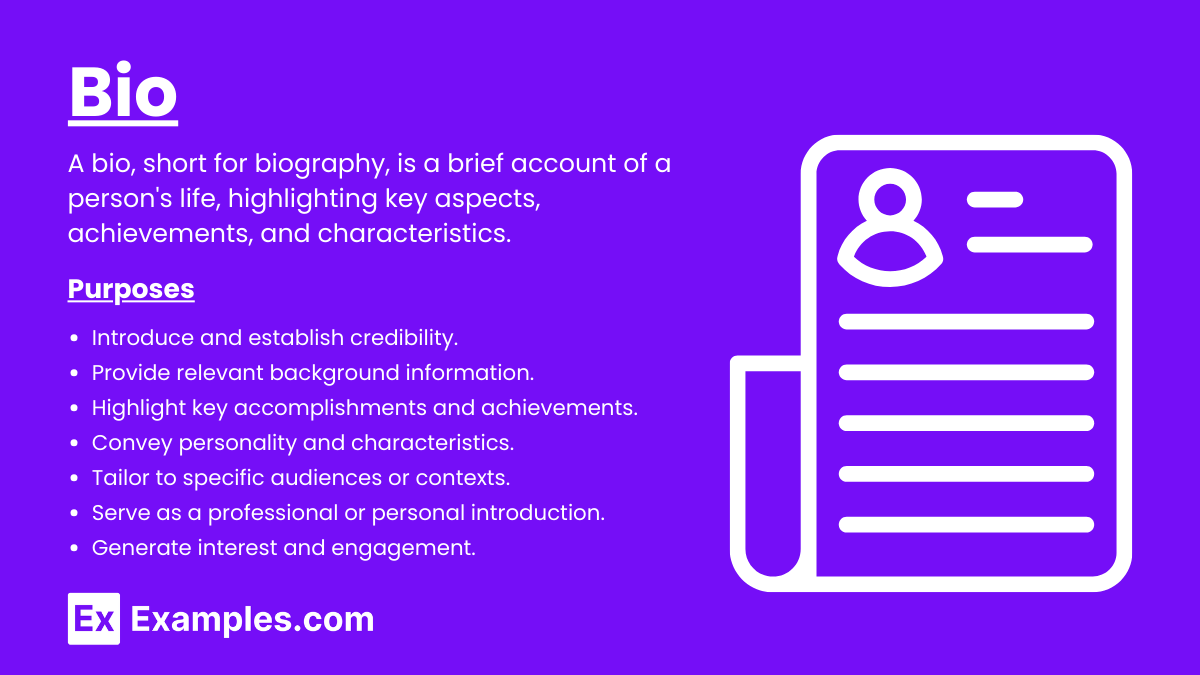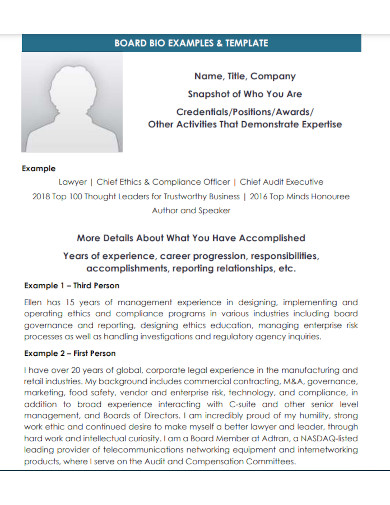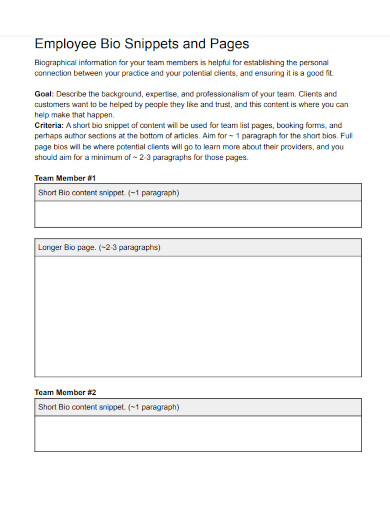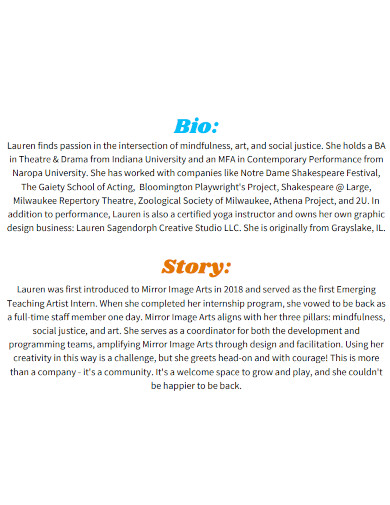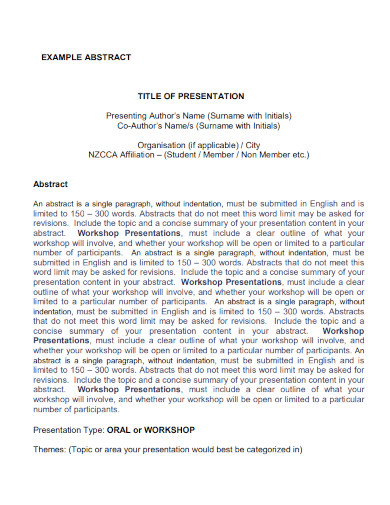40+ Bio Examples
A bio, short for biography, is a concise narrative that highlights an individual’s life, achievements, and professional background. It serves as a snapshot of one’s career and personal milestones, often used in professional contexts like resumes, social media profiles, company websites, and even on identification cards. When paired with well-designed ID card templates, a bio can add a professional touch to ID cards by briefly summarizing the holder’s role or credentials. A well-crafted bio can establish credibility, showcase expertise, and engage the intended audience effectively.
What Is a Bio?
A bio is a brief summary of a person’s background, skills, and accomplishments. It is used in professional settings, such as websites, social media profiles, and resumes. A good bio includes key information such as the individual’s name, occupation, education, experience, and notable achievements. It should be concise, engaging, and tailored to the intended audience.
Format of a Bio
When crafting a bio, it’s essential to include key elements that provide a clear and engaging overview of the individual’s background and achievements. Here’s a standard format:
- Name and Title:
- Start with your full name and current professional title or role.
- Professional Background:
- Summarize your career history, including past positions and relevant experience.
- Education:
- Mention your educational background, including degrees and institutions.
- Notable Achievements:
- Highlight significant accomplishments, awards, or recognitions.
- Skills and Expertise:
- List key skills and areas of expertise that are relevant to your profession.
- Personal Touch:
- Include a personal element, such as hobbies, interests, or a brief personal philosophy.
- Contact Information:
- Provide ways for people to contact you, such as email, social media links, or a website.
Examples of Bio
1. Professional Bio – LinkedIn Profile
LinkedIn Profile:
John Smith is a seasoned marketing professional with over 15 years of experience in the industry. Specializing in digital marketing strategies and brand development, John has successfully led numerous campaigns that have significantly increased brand awareness and revenue for his clients. Currently serving as the Marketing Director at XYZ Corporation, he is known for his innovative approach and leadership skills. John holds an MBA from Harvard Business School and is a certified Digital Marketing Expert. When not working, he enjoys mentoring young marketers and exploring new digital trends.
2. Personal Bio – Blog Author Page
Blog Author Page:
Hi, I’m Jane Doe, a passionate traveler and food enthusiast. On this blog, I share my adventures and culinary experiences from around the world. With a background in journalism, I aim to tell compelling stories that not only entertain but also inspire others to explore new places and cultures. When I’m not traveling or writing, you can find me experimenting with new recipes in my kitchen or hiking in the great outdoors. Join me on my journey and let’s discover the world together, one bite at a time!
3. Academic Bio – Conference Speaker
Conference Speaker:
Dr. Emily White is a leading researcher in environmental science, focusing on climate change and sustainable development. She holds a PhD from Stanford University and has published over 50 peer-reviewed articles in top scientific journals. Dr. White’s groundbreaking research on renewable energy sources has earned her several prestigious awards, including the Green Scientist Award. Currently, she is a professor at the University of California, Berkeley, where she also mentors graduate students. Dr. White is a sought-after speaker at international conferences and actively collaborates with global organizations to promote sustainable practices.
4. Creative Bio – Artist Portfolio
Artist Portfolio:
Alex Johnson is a contemporary visual artist whose work explores the intersection of urban life and nature. With a background in graphic design and fine arts, Alex combines traditional techniques with digital media to create thought-provoking pieces. His artwork has been exhibited in galleries across the United States and featured in several art magazines. Alex draws inspiration from his surroundings, often incorporating elements of street art and organic forms into his creations. In addition to his solo exhibitions, he collaborates with other artists on public art projects aimed at revitalizing urban spaces.
5. Entrepreneur Bio – Startup Website
Startup Website:
Maria Rodriguez is the founder and CEO of EcoTech Solutions, a company dedicated to developing innovative eco-friendly technologies. With a degree in mechanical engineering and a passion for sustainability, Maria has led EcoTech from a small startup to a leading player in the green tech industry. Under her leadership, the company has launched several groundbreaking products that have won numerous awards for their environmental impact. Maria is also an advocate for women in STEM and actively mentors young female entrepreneurs. Her vision is to create a more sustainable future through technology and innovation.
6. Social Media Bio – Instagram Profile
Instagram Profile:
🌿 Sara Green | Plant Enthusiast 🌱 | Sharing my journey of growing and caring for indoor plants. From tips and tricks to plant decor ideas, join me in creating a greener, healthier home! 🌿 #PlantLover #UrbanJungle #GreenLiving
7. Freelancer Bio – Personal Website
Personal Website:
Michael Brown is a freelance web developer with over 10 years of experience in creating stunning, user-friendly websites. Specializing in front-end development and UX design, Michael has worked with a diverse range of clients, from small startups to large corporations. His passion for coding and design drives him to stay updated with the latest industry trends and technologies. Michael believes in delivering high-quality work that exceeds client expectations. In his free time, he enjoys contributing to open-source projects and blogging about web development tips and tricks.
8. Healthcare Professional Bio – Clinic Website
Clinic Website:
Dr. Lisa Chen is a board-certified family physician with over 20 years of experience in providing comprehensive healthcare services. She is committed to offering personalized care to patients of all ages, with a special interest in preventive medicine and chronic disease management. Dr. Chen received her medical degree from Johns Hopkins University and completed her residency at Mayo Clinic. She is known for her compassionate approach and dedication to patient education. Outside of the clinic, Dr. Chen enjoys volunteering at local health fairs and staying active with yoga and hiking.
9. Tech Professional Bio – Conference Speaker
Conference Speaker:
Samuel Lee is a cybersecurity expert with a decade of experience in protecting organizations from digital threats. As the Chief Information Security Officer at SecureNet Inc., Samuel leads a team of professionals dedicated to safeguarding sensitive information and ensuring compliance with industry regulations. He holds a Master’s degree in Information Security from MIT and is a certified Ethical Hacker. Samuel is a frequent speaker at international cybersecurity conferences and has authored several articles on emerging security trends. In his spare time, he enjoys ethical hacking challenges and mentoring aspiring cybersecurity professionals.
10. Non-Profit Leader Bio – Organization Website
Organization Website:
Anna Martinez is the Executive Director of Helping Hands, a non-profit organization dedicated to providing resources and support to underprivileged communities. With over 15 years of experience in the non-profit sector, Anna has successfully led numerous initiatives aimed at improving education, healthcare, and economic opportunities for those in need. She holds a Master’s degree in Social Work from Columbia University and is a passionate advocate for social justice. Under her leadership, Helping Hands has expanded its programs and increased its impact significantly. Anna is also a motivational speaker and enjoys connecting with community members to drive positive change.
Examples of Bio for Work
1. Marketing Professional
Company Website:
Sarah Johnson is a dynamic marketing strategist with over a decade of experience in creating impactful marketing campaigns. At ABC Marketing, she specializes in digital marketing, brand management, and consumer engagement. Sarah holds a BA in Marketing from NYU and is Google Analytics certified. Known for her creative solutions and data-driven approach, she has helped numerous brands achieve significant growth. Outside of work, Sarah enjoys attending industry conferences and staying ahead of marketing trends.
2. Software Engineer
Team Page:
James Lee is a senior software engineer at Tech Innovations, where he leads a team in developing cutting-edge software solutions. With expertise in full-stack development and a passion for problem-solving, James has contributed to several high-profile projects. He holds a BSc in Computer Science from MIT and has a strong background in AI and machine learning. In his free time, James enjoys coding for open-source projects and participating in hackathons.
3. Human Resources Manager
LinkedIn Profile:
Emily Davis is an accomplished Human Resources Manager with over 15 years of experience in employee relations, recruitment, and organizational development. At XYZ Corp, she is known for her strategic approach to HR and her ability to foster a positive workplace culture. Emily holds a Master’s degree in Human Resources Management from the University of Chicago and is SHRM-SCP certified. She is passionate about continuous learning and professional development, both for herself and her team.
4. Financial Analyst
Company Bio:
Robert Miller is a seasoned financial analyst at Global Investments Inc., where he provides in-depth financial insights and strategic recommendations to clients. With a strong background in financial modeling, forecasting, and risk management, Robert has been instrumental in driving investment decisions. He holds an MBA from Wharton School of Business and is a CFA charterholder. Robert is committed to staying current with market trends and enjoys mentoring junior analysts.
5. Project Manager
Professional Networking Site:
Olivia Brown is a certified Project Management Professional (PMP) with over 12 years of experience in managing complex projects in the IT and construction industries. At BuildTech Solutions, she excels in delivering projects on time and within budget while ensuring client satisfaction. Olivia holds a degree in Civil Engineering from Stanford University and is known for her leadership and communication skills. She actively participates in project management forums and is dedicated to continuous improvement.
Examples of Bio for Students
1. High School Student – College Application
College Application:
Jessica Martinez is a senior at Lincoln High School, where she excels in both academics and extracurricular activities. She is the president of the student council, captain of the debate team, and a member of the National Honor Society. Jessica has a passion for community service, having volunteered over 200 hours at her local food bank. She plans to pursue a degree in Political Science and hopes to become a lawyer to advocate for social justice. In her free time, Jessica enjoys reading historical novels and hiking.
2. College Student – LinkedIn Profile
LinkedIn Profile:
Michael Nguyen is a junior at the University of California, Berkeley, majoring in Computer Science. With a strong foundation in programming languages such as Python, Java, and C++, Michael has developed several innovative software projects. He is an active member of the ACM Student Chapter and participates in hackathons and coding competitions. Michael is currently seeking an internship in software development to apply his skills and gain practical experience. Outside of academics, he enjoys playing chess and running marathons.
3. Graduate Student – Research Profile
Research Profile:
Emily Thompson is a graduate student at Harvard University, pursuing a Master’s degree in Environmental Science. Her research focuses on sustainable agriculture and climate change mitigation. Emily has published two papers in peer-reviewed journals and presented her findings at several international conferences. She is a recipient of the Fulbright Scholarship and is passionate about using her research to drive positive environmental change. In addition to her studies, Emily is a teaching assistant and mentors undergraduate students interested in environmental science.
4. Art Student – Portfolio Website
Portfolio Website:
Alexandra Kim is an art student at the Rhode Island School of Design, specializing in illustration and graphic design. Her work is characterized by vibrant colors and intricate details, often inspired by nature and urban life. Alexandra has showcased her art in several exhibitions and has won awards for her digital illustrations. She is proficient in Adobe Creative Suite and enjoys experimenting with different media. Alexandra aspires to become a professional illustrator and hopes to publish her own graphic novels. In her spare time, she loves exploring new art forms and collaborating with other artists.
5. Medical Student – Professional Bio
Professional Bio:
John Park is a third-year medical student at Johns Hopkins University School of Medicine, with a focus on pediatrics. He has completed clinical rotations in various departments, gaining hands-on experience in patient care. John is actively involved in medical research, having contributed to studies on pediatric infectious diseases. He is also the president of the Pediatrics Club and volunteers at local health clinics. John is dedicated to improving child health and plans to pursue a residency in pediatrics. When not studying or volunteering, he enjoys playing the piano and participating in community sports leagues.
Examples of Bio for Business
1. Executive Bio – CEO
Company Website:
Jane Doe is the CEO of Tech Innovations Inc., leading the company towards groundbreaking advancements in artificial intelligence and machine learning. With over 20 years of experience in the tech industry, Jane has a proven track record of driving growth and innovation. She holds an MBA from Harvard Business School and has been recognized as one of Forbes’ Top 50 Women in Tech. Under her leadership, Tech Innovations has seen a 300% increase in revenue and expanded its global presence. Outside of work, Jane is passionate about mentoring young entrepreneurs and advocating for diversity in tech.
2. Entrepreneur Bio – Startup Founder
Startup Website:
John Smith is the founder and CEO of GreenTech Solutions, a startup focused on developing sustainable energy solutions. John holds a degree in Environmental Engineering from MIT and has over 15 years of experience in renewable energy. His innovative approach to clean energy has earned GreenTech several awards, including the Startup of the Year award at the Global Green Energy Summit. John is committed to creating a more sustainable future and frequently speaks at industry conferences. In his free time, he enjoys hiking and volunteering for environmental causes.
3. Sales Professional Bio
LinkedIn Profile:
Michael Brown is a seasoned sales professional with over 10 years of experience in the SaaS industry. Currently, he is the Sales Director at Cloud Solutions Inc., where he leads a team of 25 sales representatives. Michael has a knack for developing high-performing teams and implementing effective sales strategies. He holds a Bachelor’s degree in Business Administration from the University of Texas and is known for his ability to close complex deals and build long-lasting client relationships. Outside of work, Michael enjoys playing golf and participating in community service activities.
4. Consultant Bio
Consulting Firm Website:
Emily Johnson is a senior management consultant at Strategic Insights, specializing in business transformation and operational efficiency. With an MBA from Wharton School of Business and over 12 years of consulting experience, Emily has successfully led numerous projects across various industries, including healthcare, finance, and manufacturing. Her strategic insights and analytical skills have helped clients achieve significant improvements in performance and profitability. Emily is passionate about helping businesses navigate change and achieve their goals. In her spare time, she enjoys reading business books and traveling.
5. Marketing Professional Bio
Company Website:
Sarah Williams is the Chief Marketing Officer at Bright Future Corp., where she oversees all marketing initiatives, including brand strategy, digital marketing, and customer engagement. With over 15 years of experience in marketing, Sarah has a deep understanding of consumer behavior and market trends. She holds a Master’s degree in Marketing from NYU and has been instrumental in driving Bright Future’s brand growth and market expansion. Sarah is also a regular contributor to industry publications and a speaker at marketing conferences. Outside of her professional life, she enjoys photography and exploring new cuisines.
Personal Bio Examples
1. Personal Blog Bio
Blog Author Page:
Hi, I’m Laura Thompson, a passionate traveler and food enthusiast. On this blog, I share my adventures and culinary experiences from around the world. With a background in journalism, I aim to tell compelling stories that not only entertain but also inspire others to explore new places and cultures. When I’m not traveling or writing, you can find me experimenting with new recipes in my kitchen or hiking in the great outdoors. Join me on my journey and let’s discover the world together, one bite at a time!
2. Social Media Bio
Instagram Profile:
🌿 Emily Green | Plant Enthusiast 🌱 | Sharing my journey of growing and caring for indoor plants. From tips and tricks to plant decor ideas, join me in creating a greener, healthier home! 🌿 #PlantLover #UrbanJungle #GreenLiving
3. Personal Website Bio
Personal Portfolio:
Welcome! I’m James Anderson, a freelance web developer and designer with a passion for creating beautiful and functional websites. With over 10 years of experience, I’ve helped businesses of all sizes enhance their online presence. I specialize in front-end development, UX/UI design, and WordPress. When I’m not coding, I enjoy hiking, photography, and exploring new technologies. Feel free to browse my portfolio and get in touch if you’d like to collaborate on a project!
4. Professional Networking Site Bio
LinkedIn Profile:
Hi, I’m Lisa Chen, an experienced project manager with a background in software development. Over the past 12 years, I’ve led numerous projects from conception to completion, ensuring they meet client expectations and are delivered on time and within budget. I hold a PMP certification and a Master’s degree in Information Systems. In my spare time, I enjoy volunteering at local animal shelters and exploring new hiking trails. Let’s connect and see how we can collaborate!
5. Community Volunteer Bio
Volunteer Organization Website:
Hello, I’m Robert Martinez, a dedicated community volunteer with a passion for making a difference. Over the past five years, I’ve been actively involved in various local initiatives, from organizing food drives to mentoring at-risk youth. I believe in the power of community and strive to contribute positively in any way I can. In my professional life, I work as a software engineer, and in my free time, I enjoy playing the guitar and running marathons. Together, we can create a stronger, more supportive community!
Examples of Bio for Social Media
1. Instagram Bio – Lifestyle Influencer
Instagram Profile:
🌸 Jessica Brown | Lifestyle Blogger 🌸 | Sharing tips on fashion, beauty, and wellness. Follow my journey to a balanced and stylish life. ✨ #Lifestyle #Fashion #Wellness
2. Twitter Bio – Tech Enthusiast
Twitter Profile:
Alex Johnson | Tech Geek 🚀 | Passionate about AI, robotics, and the latest in tech innovation. Follow for updates, insights, and the occasional tech meme. #Tech #AI #Innovation
3. LinkedIn Bio – Professional Networking
LinkedIn Profile:
Emily Smith | Marketing Professional | Specializing in digital marketing and brand strategy. Helping businesses grow through innovative marketing solutions. Connect to collaborate! #Marketing #DigitalStrategy #BrandDevelopment
4. Facebook Bio – Personal Profile
Facebook Profile:
Hi, I’m Michael Thompson! Avid traveler, foodie, and tech enthusiast. I love sharing my adventures, culinary experiments, and tech discoveries with friends and family. Join me on this journey! #Travel #Foodie #TechLover
5. TikTok Bio – Content Creator
TikTok Profile:
🎥 Sarah Lee | Content Creator 🎥 | Fun DIY projects, life hacks, and everyday adventures. Making life a little more creative, one video at a time. Follow along! #DIY #LifeHacks #Creative
6. Instagram Bio – Fitness Coach
Instagram Profile:
💪 Chris Evans | Fitness Coach 💪 | Helping you achieve your fitness goals with personalized training plans and motivational tips. Transform your body and mind. #Fitness #Training #Health
7. Twitter Bio – Writer
Twitter Profile:
Anna Davis | Writer ✍️ | Sharing thoughts on literature, writing tips, and my journey as an author. Lover of books and coffee. #Writing #Literature #AuthorLife
8. LinkedIn Bio – Career Consultant
LinkedIn Profile:
John Lee | Career Consultant | Guiding professionals towards successful career transitions and growth. Expertise in resume writing, interview coaching, and job search strategies. #CareerDevelopment #JobSearch #ProfessionalGrowth
9. Facebook Bio – Musician
Facebook Profile:
Hey, I’m Emily Carter! Musician and songwriter. I share my original songs, covers, and behind-the-scenes glimpses of my musical journey. Let’s make music together! #Music #Songwriter #LiveMusic
10. TikTok Bio – Chef
TikTok Profile:
👩🍳 Laura Gomez | Chef 👩🍳 | Delicious recipes, cooking tips, and kitchen hacks. Bringing gourmet cooking to your home. Follow for mouth-watering dishes! #Cooking #Recipes #ChefLife
More Sample & Templtes for Bio in PDF
1. Board Bio Examples & Template
2. Employee Bio Content Template
3. Bio and Story Template
4. Sample Bio Template
5. Abstract Bio Template
Purpose of a Bio
A biography, often referred to as a “bio,” serves multiple purposes, making it a valuable tool in various contexts. Here are the primary purposes of a bio:
1. Introduction
A bio introduces an individual to the audience, providing essential details about who they are. This introduction can be crucial in professional settings, networking events, or online profiles.
2. Establishing Credibility
A well-crafted bio highlights an individual’s qualifications, achievements, and expertise, establishing their credibility. This is particularly important for professionals, academics, and public figures.
3. Personal Branding
A bio helps in personal branding by showcasing an individual’s unique qualities, skills, and experiences. It allows individuals to present themselves in a way that aligns with their personal and professional goals.
4. Building Trust
By sharing personal and professional experiences, a bio can build trust with the audience. It offers insights into the individual’s background, making them more relatable and trustworthy.
5. Networking
In networking scenarios, a bio acts as a conversation starter. It provides a quick overview of an individual’s background, making it easier to find common interests and establish connections.
6. Professional Opportunities
A comprehensive bio can open doors to various professional opportunities, such as job offers, speaking engagements, collaborations, and more. It allows potential employers or partners to quickly assess the individual’s suitability for specific roles or projects.
7. Online Presence
In the digital age, a bio is essential for creating an online presence. Whether on social media, personal websites, or professional platforms like LinkedIn, a bio ensures that the individual is accurately represented online.
8. Marketing and Promotion
For authors, artists, and entrepreneurs, a bio serves as a marketing tool. It helps in promoting their work, attracting potential clients or readers, and enhancing their visibility in their respective fields.
9. Educational Purposes
In educational settings, a bio can provide context about a person’s academic background and contributions. It can be included in course materials, conference programs, and academic publications.
10. Context for Achievements
A bio offers context for an individual’s achievements, explaining the significance of their work and the impact they have made in their field or community.
How to Write a Bio
Step 1: Determine the Purpose and Audience
- Identify the purpose of your bio (e.g., professional profile, personal introduction).
- Understand who will read it (e.g., potential employers, colleagues, social media followers).
Step 2: Start with Your Name, Title, and Current Position
- Begin with your full name and professional title.
- Mention your current job or main occupation.
Example: “Jane Doe, Marketing Specialist at XYZ Company”
Step 3: Highlight Key Achievements and Experiences
- Summarize your most relevant work experiences and accomplishments.
- Focus on what sets you apart in your field.
Example: “With over 10 years of experience in digital marketing, Jane has spearheaded numerous successful campaigns, resulting in a 30% increase in online engagement for her clients.”
Step 4: Mention Your Education and Skills
- Include your educational background.
- List key skills and areas of expertise.
Example: “Jane holds a Master’s degree in Marketing from the University of California and a Bachelor’s degree in Business Administration from Stanford University. Her expertise includes SEO, social media marketing, and data-driven campaign analysis.”
Step 5: Add Personal Interests and Contact Information
- Share personal interests to make your bio more relatable.
- Provide ways for readers to connect with you, such as your email or social media handles.
Example: “In her free time, Jane enjoys hiking, photography, and volunteering at local animal shelters. Connect with Jane on LinkedIn at linkedin.com/in/janedoe.”
Step 6: Write in Third Person, Keep It Concise, and Proofread
- Write in third person for a professional tone.
- Keep your bio clear and concise (100 to 300 words).
- Edit and proofread to ensure it’s free of errors.
Why is a bio important?
A bio provides a quick overview of your professional background, achievements, and expertise, helping to establish your credibility and build your personal brand.
How long should a bio be?
Typically, a professional bio should be one to two paragraphs, around 100-150 words, providing concise yet comprehensive information about you.
What should be included in a bio?
A bio should include your name, current position, past experience, education, notable achievements, and any relevant personal details or interests.
Should a bio be written in the first or third person?
Bios can be written in either first person for a more personal touch or third person for a formal tone, depending on the context.
How often should you update your bio?
Update your bio regularly, especially when you achieve new milestones, change jobs, or acquire new skills to keep it current and relevant.
Can a bio be used on different platforms?
Yes, tailor your bio slightly for each platform, maintaining consistency while adapting to the specific audience and purpose of each platform.
How can a bio help in networking?
A well-crafted bio can attract potential contacts, showcase your expertise, and provide talking points, making it easier to initiate and sustain professional relationships.
What tone should a bio have?
Match the tone of your bio to the context—professional and polished for business settings, more relaxed and personable for social media or creative industries.
How can you make your bio stand out?
Include unique achievements, personal anecdotes, or insights that highlight your individuality and make your bio memorable to readers.
Is it necessary to include personal interests in a bio?
Including personal interests can make your bio more relatable and well-rounded, but ensure they are relevant and appropriate for the audience.



